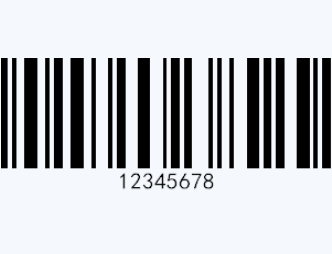Among the various types of barcodes, the 1D barcode stands out for its simplicity and widespread use. From retail stores to libraries, 1D barcodes are a familiar sight.
They play a crucial role in facilitating quick data entry and efficient tracking. With the advent of the 1D barcode generator, creating these barcodes has become even more accessible.
What is a 1D Barcode?
A 1D barcode, also known as a linear code, consists of parallel lines with varying widths and spacings that represent data.
This data can be anything from product information to serial numbers. The primary feature of a 1D barcode is that it encodes data in a linear format, read horizontally.

How 1D Barcodes Work
The structure of a 1D barcode is straightforward. It consists of a series of black and white bars that encode information based on their width and spacing.
This information is typically read by a 1D barcode scanner, which uses a light source to scan the barcode and interpret the reflected light patterns into digital data.
Types of 1D Barcodes
1D barcodes come in various formats, each serving different purposes. Here are some of the most common types:
Barcode Type | Description | Use Cases |
UPC | 12-digit numeric barcode is widely used in retail. | Product identification, point-of-sale. |
EAN | 8 or 13-digit numeric barcode used in Europe. | European retail, international trade. |
Code 39 | Alphanumeric barcode for versatile data. | Industrial settings, asset tracking. |
Code 128 | High-density barcode encoding all 128 ASCII characters. | Shipping, logistics, supply chain. |
Interleaved 2 of 5 (ITF) | Numeric barcode encoding pairs of digits. | Carton labeling, warehouse management. |
Codabar | Simple numeric barcode for specific applications. | Libraries, blood banks, airbills. |
Benefits of Using 1D Barcodes
1D barcodes offer numerous advantages, particularly in inventory management:
● Cost-effective: Low cost of implementation and maintenance.
● Speed and Accuracy: Fast scanning and reduced human error in data entry.
● Simplicity: Easy to generate and use with minimal training required.
1D Barcode vs 2D Barcode
Understanding the difference between 1D barcode and 2D barcode is crucial for selecting the right technology for your needs.
While 1D barcodes linearly store data, 2D barcodes (like QR codes) can store data both horizontally and vertically, offering higher data capacity. Here are some key differences:
● Data Capacity: 1D barcodes hold less data compared to 2D barcodes.
● Space Efficiency: 2D barcodes can store more information in a smaller space.
● Scanning Requirements: 2D barcodes often require more sophisticated scanners.
Despite these differences, 1D barcodes are still preferred in many scenarios due to their simplicity and ease of use.
How to Create 1D Barcodes?
Creating a 1D barcode is simple, especially with online tools. Here's a step-by-step guide:
1. Select a Barcode Format: Choose the appropriate 1D barcode format for your needs (e.g., UPC, Code 128).

2. Enter Data: Input the data you want to encode.
3. Generate the Barcode: Use an online 1D barcode generator to create the barcode.
4. Download and Print: Save the generated barcode and print it on labels or products.
For best results, ensure the barcode is printed with high contrast and sufficient resolution to be easily scanned.
Once you've created your 1D barcode, you'll need a 1D barcode scanner to read and interpret the data.
Hold the scanner at an appropriate distance from the barcode, typically a few inches away, ensuring the entire barcode is within the scanner's range. The scanner interprets the reflected light patterns into digital data, which is then sent to your connected system for processing.
Applications of 1D Barcodes
1D barcodes are widely utilized across various industries due to their efficiency and simplicity:
1. Retail and Inventory Management
1D barcodes are extensively used in retail for product identification and sales processing.
Each product is assigned a unique barcode, such as a UPC, which is scanned at the point of sale to update inventory levels and process transactions efficiently.
For example, when a cashier scans the barcode on a box of cereal, the system automatically deducts the item from the store's inventory and records the sale.
2. Manufacturing:
In manufacturing, 1D barcodes enhance production line efficiency and quality control.
Parts and components are labeled with barcodes like Code 39 or Code 128, enabling precise tracking throughout the production process.
For instance, scanning the barcode on a component ensures it is correctly placed and recorded in the system, facilitating seamless assembly and reducing errors.
3. Logistics and Supply Chain Management:
1D barcodes streamline logistics and supply chain operations by improving the accuracy of tracking shipments and managing warehouse inventories.
Packages and pallets are labeled with barcodes like Code 128, allowing for real-time scanning and updating of shipment statuses throughout the supply chain.
For example, when a package arrives at a distribution center, its barcode is scanned to update its location in the tracking system, ensuring efficient handling and timely delivery.
FAQs about 1D Barcodes
1. How can you tell if a barcode is 1D or 2D?
A 1D barcode is linear and read horizontally, while a 2D barcode has a grid pattern that stores data both vertically and horizontally.
2. What is the difference between 1D, 2D, and 3D barcode scanners?
1D scanners read linear barcodes, 2D scanners read both 1D and 2D barcodes, and 3D scanners, though less common, can capture depth information.
3. What is the difference between a 1D barcode and a QR code?
A QR code is a type of 2D barcode with higher data capacity and can encode URLs, text, and more.
In summary, 1D barcodes are indispensable tools for efficient data management and tracking across various industries.
Their simplicity, cost-effectiveness, and reliability make them a popular choice.
To harness the power of 1D barcodes in your business, consider using an online 1D barcode generator.
By doing so, you can improve accuracy, streamline operations, and enhance overall efficiency.
Explore our online barcode generator to create 1D barcodes effortlessly!




